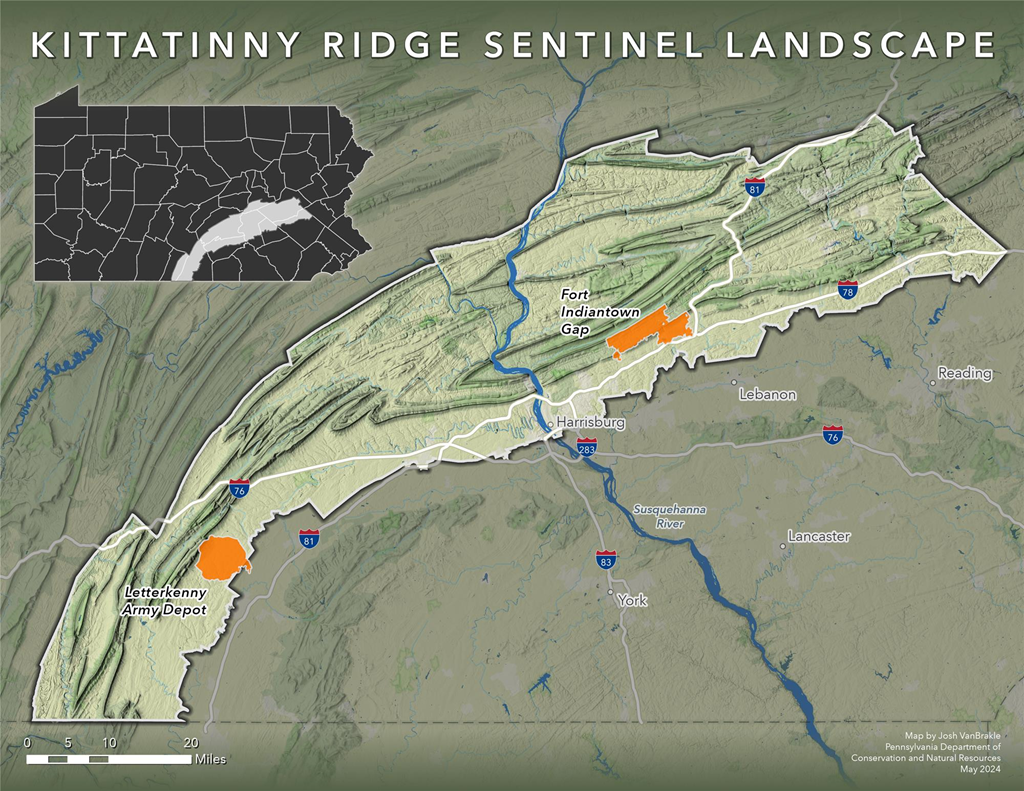Hawk Mountain Sanctuary included in new Sentinel Landscape to Address Climate Change Impacts and Strengthen Military Readiness
Posted on May 22, 2024 in General

The Shapiro Administration announced last week the designation of Pennsylvania’s Kittatinny Ridge as a Sentinel Landscape, which includes Hawk Mountain Sanctuary.
Founded in 2013 by the U.S. Department of Agriculture (USDA), Department of Defense (DOD), and Department of the Interior (DOI), the Sentinel Landscapes Partnership’s mission is to strengthen military readiness, conserve natural resources, bolster agricultural and forestry economies, increase public access to outdoor recreation, and enhance resilience to climate change.
Five new sentinel landscapes were designated, including the new Kittatinny Ridge Sentinel Landscape, which includes the Sanctuary, and is the only new Sentinel Landscape in Pennsylvania. Hawk Mountain Sanctuary is famous as the first refuge for birds of prey, an international center for raptor conservation, and a safehold for the wildlife that migrates along this mega migration and globally important Kittatinny Ridge conservation corridor.
In these landscapes, natural and working lands thrive alongside military installations and ranges, in this case, Fort Indiantown Gap.
“The partnership supports collaborative efforts to mitigate climate change impacts and improve sustainable land and water management practices around military installations,” says Hawk Mountain President Sean Grace.
Hawk Mountain Sanctuary also has been instrumental in promoting the importance of conserving the Kittatinny as a Globally Important Bird Area and mega-migration super highway.
“The Sanctuary was part of the working group on the proposal for the designation and Hawk Mountain migration data forms the backbone foundation of the work that led to Important Bird Area status,” explains Director of Conservation Science Dr. Laurie Goodrich.
The 2024 sentinel landscape designations include:
Kittatinny Ridge Sentinel Landscape, Pennsylvania
Eastern New Mexico Sentinel Landscape, New Mexico
Great Salt Lake Sentinel Landscape, Utah
Hawaiʻi Sentinel Landscape, Kauaʻi, Oʻahu, and Hawaiʻi Island
Mojave Desert Sentinel Landscape, California
“Through the Sentinel Landscapes Partnership, we have worked with private landowners to permanently protect more than 515,000 acres and implement sustainable management practices on an additional 2.7 million acres around military testing and training areas,” said USDA Natural Resources Conservation Service Chief, Terry Cosby.
“These efforts preserve wildlife habitat, bolster agricultural and forest production, and support climate resiliency, among other benefits, while at the same time ensuring our military has the space it needs for its operations. This work showcases the power of collaboration and partnership to help us meet our mission.”
Learn About the Kittatinny Ridge Sentinel Landscape
Kittatinny Ridge | Sentinel Landscapes
Read more about the Sentinel Landscapes Partnership’s mission and accomplishments at sentinellandscapes.org.
Kittatinny Ridge Sentinel Landscape, Pennsylvania
In the Lenape language, Kittatinny means “Big Mountain,” which describes the geography of Kittatinny Ridge Sentinel Landscape well. Located in eastern Pennsylvania’s Appalachian Mountains, it encompasses forested ridges and fertile valleys that provide clean water, sequester vast amounts of carbon, and serve as a crucial corridor for rare wildlife and songbird migration. The landscape is anchored by Fort Indiantown Gap, the busiest National Guard training center, the Army’s second busiest heliport, and one of only three specialized Army National Guard aviation facilities. With the primary mission of preserving military mission readiness, operations, testing and training capabilities, KRSL partners are focused on increasing coordinated and holistic land conservation, natural resource protection, and stewardship initiatives; supporting working lands productivity and economic development; and improving nature-based recreational resources and access to sustain small-town economies.
# # #